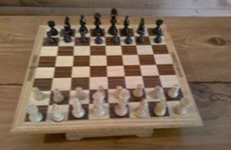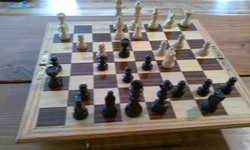Space Management Chess
Space management for a professional driver is like a game of chess. Chess has fundamentals. Trainees start by learning these fundamentals. The beginning chess player can win a lot of matches simply by mastering the fundamentals. Protect your King and Queen. Look at what your opponent can do next. If your opponent's only Bishop is on the dark squares, put your most important pieces in the light squares. Do the fundamental things first.
 Professional drivers must master our fundamentals. PAY ATTENTION! Manage your following distance. Is there a vehicle in your blind spots? Awareness begets anticipation. Drive long enough and you can predict a lane changer before they signal their intentions. No matter how well you learn to predict the movements of the vehicles around you, DRIVE DEFENSIVELY. Be prepared. Don't put yourself in a defenseless position.
Professional drivers must master our fundamentals. PAY ATTENTION! Manage your following distance. Is there a vehicle in your blind spots? Awareness begets anticipation. Drive long enough and you can predict a lane changer before they signal their intentions. No matter how well you learn to predict the movements of the vehicles around you, DRIVE DEFENSIVELY. Be prepared. Don't put yourself in a defenseless position.
After you learn the fundamentals, you can begin more advanced strategies. In chess, you may learn to castle to better protect your King. Perhaps on offense you can learn to hide your attack pieces behind a pawn. By moving your pawn you can gain a significant advantage. No matter how advance you get, never lose track of the fundamentals. Your opponents (other drivers) may do the unexpeted.
Combining a truly professional driver with modern technology is the best of both worlds. The professional driver, like the master chess player, is always thinking ahead, while staying in the present. Staying in the present helps avoid those nasty paint swaps. Thinking ahead not only can help avoid swapping paint, but enhance overall performance.
Keeping a 4 second following distance is adequate for safety. Increasing that distance to 7 seconds  improves vehicle performance. That is even more significant with modern technology. That extra following distance enables the modern technology to do its thing. Take Collision Mitigation Systems. They are designed as a safeguard. When the system engages, it thwarts forward momentum. So you want to prevent if from engaging. My system anticipates about 3.6 seconds. The idea is to out anticipate the system. With a 4 second following distance, that gives you less than a half second lead on the system. The 7 second following distance gives you an additional 3 seconds to react.
improves vehicle performance. That is even more significant with modern technology. That extra following distance enables the modern technology to do its thing. Take Collision Mitigation Systems. They are designed as a safeguard. When the system engages, it thwarts forward momentum. So you want to prevent if from engaging. My system anticipates about 3.6 seconds. The idea is to out anticipate the system. With a 4 second following distance, that gives you less than a half second lead on the system. The 7 second following distance gives you an additional 3 seconds to react.
GPS predictive cruise control is constantly thinking more than a mile ahead. It is concerned with the topography of the road ahead. The system maximizes vehicle performance by using gravity efficiently. If you are too close to the vehicle in front of you, it lessens the ability of the technology, to maximize efficiency. It is never about professional driver versus modern technology. It is about modern technology helping the professional driver maximizing efficiency and safety. Maximizing technology requires a professional driver who understands both the old shcool fundamentals and advanced modern technolgy.